posted by Dave Arnold Â
We are the “Tech N Stuff” blog. Here is some “N Stuff.”Â
I have many pig books.  Bacon and Hams, by George J. Nicholls, is one of my two favorites of all time (here is the other). It is weird, witty and beautiful – and unavailable today. It was published in 1917 , with a second edition in 1924. Google books hasn’t scanned it yet (Google take note!). But don’t despair. Below I will provide some of the book’s best stuff. You’ll feel like you’ve read it.          Â
 Back in 2004 I was organizing an exhibition about American country hams –how great they are, how we should eat more of them, etc, etc. I read every book on pigs or ham in the New York Public Library system. Every single one (here is a 700K pdf of the show). Nicholls’ “Bacon and Hams” jumped out as something special –the frontispiece of the book had a spectacular fold-out.  At the time the book was written, fold-out anatomical charts were a popular feature in medical books. Nicholls decided to do one of the pig. Brilliant. I’ve scanned it and converted it to a Flash animation for your enjoyment:Â

Just after the frontispiece is this striking photo:       Â
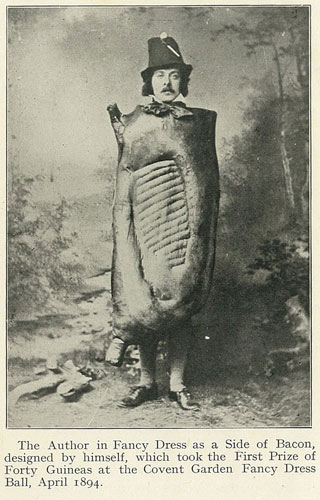
Wow. I immediately stopped what I was doing, went on www.bookfinder.com, and located a perfect copy for 20 dollars. Sadly, you will not find that deal today.   Â
Who was George J. Nicholls? I could find very little. According to the title page, George J. Nicholls C.C., F.R.C.I., F.G.I. was the director of the provisions company George Bowles, Nicholls & Co.; Trustee, Member of Council, Chairman of Finance Committee, and honorary Examiner to the Institute of Certified Grocers; Chairman of Committee of the London Provision Exchange; Past Chairman of the Wholesale Produce Merchants’ Association, London; Past-President of the National Federation of Produce Merchants; Member of Committee, Provision Section, London Chamber of Commerce. He also had three sons –only two of whom joined the family bacon business.  How could such an august personage leave such a small trace in history?       Â
“Bacon and Hams” could have been merely a 104 page technical trade book; in Nicholls’ hands it became a paean to the pig.  The book grew out of a series of lectures Nicholls gave on the ins and outs of the bacon biz.  It displays his love of curing pork, picking out swine, and learning how the industry worked across the world. It begins by quoting Professor Oxholm, court physician to the King of Denmark:      Â
There is no better breakfast than bacon, especially when cured and smoked, and cooked in the delicious English way… the ideal breakfast for the masses, adults as well as children, is a couple of rashers of fat bacon and a slice or two of crisp toast spread with bacon dripping.       Â
Nicholls continues:Â Â Â Â Â Â Â Â
And, indeed, the very suggestion is appetizing and forms a fitting opening to this book of Bacon. All men have an interest in bacon, with the exception, perhaps, of the Jew and the vegetarian; and the man of little imagination, but of sound appetitive instincts, who had bacon and eggs for breakfast one morning, and varied monotony by ordering eggs and bacon the next, was more than justified by the almost unanimous vote of the community –the pig, with some assistance from the hen, is the true autocrat of the breakfast table!       Â
Well, he forgot Muslims; but otherwise I couldn’t agree more.  Here are some choice tidbits from the rest of the book:      Â
How to bone:Â Â Â Â Â Â Â
Nicholls got his good buddy, Mr Alfred W. Childs, M. G. I. to contribute an appendix on the Boning of Fore-Hocks and Gammons. It is nearly impenetrable but I still love it. It is the most scientifically phrased butcher’s manual I have ever seen. It is written for a surgeon. The diagrams are wonderful:      Â
 Â Â Â Â Â Â Â Â Â Â Â Â Â Â Â Â Â Â Â Â Â Â Â Â Â Â
                         Â
What is Bacon?   Â
When we say bacon we mean the cured belly of the pig. Back in Nicholls’ day, a bacon was the cured whole side of the pig.  The favored way to  trim a bacon hog was called the Wiltshire Cut. Here it is:Â
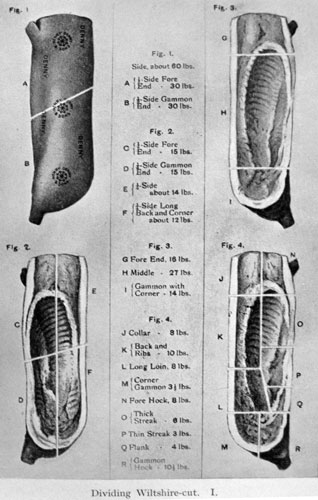
Common Pigs of England (in 1917):Â Â Â Â Â Â Â
Nicholls lists the most common pigs in England and for which locales they are best suited. Some current heritage favorites are in there, like Tamworth and Berkshire.Â
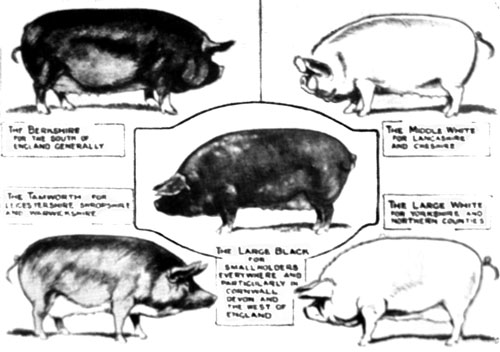
Just a Great Photo:Â Â Â Â Â Â Â Â Â Â Â Â Â Â Â Â Â Â Â Â Â Â Â Â Â

Times Have Changed:Â Â Â Â Â Â Â Â Â Â Â Â Â Â Â Â Â Â Â Â Â Â Â Â Â
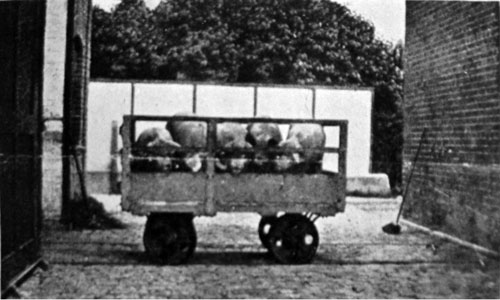
Nicholls Tours the Armour Plant in the Chicago Stockyards:Â Â Â Â Â Â Â
Nicholls gives a fantastic account of the Chicago stockyards, complete with pictures, just a couple of years after Upton Sinclair’s The Jungle came out.      Â
 Â Â Â Â Â Â Â Â Â Â Â Â Â Â Â Â Â Â Â Â Â Â Â Â Â Â
                         Â
He describes the killing floor of the factory, and the large hoist ironically dubbed “The Wheel of Fortune,” by the slaughterhouse workers:Â Â Â Â Â Â Â
The sound animal has not long to wait for his turn, and is driven along a narrow passage untill he arrives at a great wooden wheel, described in jocular vein as the “wheel of fortune.” By means of this he is hoisted, after being shackled by a chain round the hind leg, to a bar down which he slides to the hog butcher, who expertly sticks him in the throat.         Â
Here it is:Â

Finally, an image of a then new-fangled hog-scraping machine:Â

Thanks for reading. Tell me if you’d like to see more reviews of obscure books.
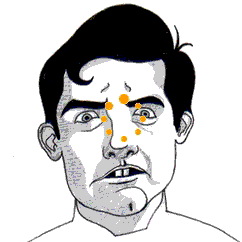
mas por favor…and I hope that we’ll one day have easier access to such things…google books or otherwise.
Wow great foldout,
it is interesting to note that in the old day pigs used to have 14 ribs (and cutlets).
Modern pigs have 16.
That what I call selective breeding.
BTW: more obscure books please!
How bout Upton Sinclair’s The Jungle next 😉
More more, yes, please! Love the Flash foldouts. And “The Boning of Fore-Hocks and Gammons” truly deserves further study.
Spectacular entry, I would LOVE to see more obscure book reviews!
more, please. also, photos of Dave and Nils in Fancy Dress of Side of Bacon would be useful.
Eat-em up Katie McManus! How are you?
But where can we get good country hams in Seattle? Aren’t they all down south?
You can find them, believe it or not, in the ID (International District). If you go down King Street. There is a deli there that carries country hams, mostly around this time of year.
Yes, yes, yes more reviews of obscure books, personally I tend to look for and buy obscure old books on wine, and the history of, but could be very tempted to broaden my scope if Bacon and Hams is anything to go by.
HELLS YES.
Dave you might find this entertaining…
http://www.questia.com/PM.qst?a=o&d=98876227
Fascinating. I bet they made some mighty good bacon!
If they are as interesting as this, I vote for more reviews of obscure books.
I would love more please
more books! and any good book buying sites would be appreciated, looking to buy a whole pig and would love to see something that shows one being broken down from a living pig to final product outside of the factory in a small scale setting.
“When we say bacon we mean the cured belly of the pig.”
Please rewrite that as “when Murkans say bacon Murkans mean the cured belly 0f the pig”. Here in good old Blighty where we use the Queen’s English rather than some strange post-Colonial dialect called Murkan, when we say bacon we bloody well still mean the cured whole side of the pig not that your average Brit understand where the various types of bacon come from on the pig. This diagram helps:
http://www.lovebacon.info/News/documents/BACONCUTSGUIDE.doc
Very cool – thanks for “flash-izing” the foldout!
On the topic of pig slaughtering (and Chicago!) folks may enjoy the video blog “Sky full of Bacon” (which doesn’t often actually address bacon, per se.) This is a link to part 1 of 2 of a long piece the author did on the path one piglet followed from family farm to slaughter to the dinner table at Blackbird:
http://www.vimeo.com/2215124
Parts 1 and 2 total to about 40 minutes, but it was well worth the time. The slaughterhouse didn’t want the actual moment of killing the pig shown, which was strange. But you’ll get a fantastic overview of the rest of the literal “life cycle” of a delicious looking pork dinner.
Thanks for the link TomD
Oh Yes Please
Nice Post, I have bookmarked your site and will return again
What would you consider to be your favorite, in print, books on pork and on charcuterie? Love your blog.
Hi Patty,
Excellent question. The last time I read all available charcuterie books in English was years ago, just prior to the release of the Ruhlman/Polcyn book. I know a number of books have been released since then so I’d hesitate to give a recommendation. I realized how far behind the curve I was the last time I visited Kitchen Arts and letters –my favorite cookbook shop in the world. I’d trust their recommendations.